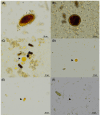Gastrointestinal Parasitic Infections in Macaca fascicularis in Northeast Thailand: A One Health Perspective on Zoonotic Risks
- PMID: 40723576
- PMCID: PMC12291805
- DOI: 10.3390/ani15142112
Gastrointestinal Parasitic Infections in Macaca fascicularis in Northeast Thailand: A One Health Perspective on Zoonotic Risks
Abstract
Gastrointestinal (GI) parasitic infections in non-human primates are of growing concern due to their implications for both veterinary and public health. Long-tailed macaques (Macaca fascicularis), commonly found in peri-urban and temple environments in Southeast Asia, may act as reservoirs for zoonotic parasites, posing risks to humans and domestic animals. This study investigated the prevalence and species diversity of GI parasites in free-ranging macaques from four provinces in Northeast Thailand (Loei, Khon Kaen, Bueng Kan, and Sisaket). A cross-sectional study was conducted between April and May 2025. A total of 445 fecal samples were examined using two parasitological techniques: agar plate culture (APC) and the formalin-ethyl acetate concentration technique (FECT). The overall prevalence of parasitic infection was 86.5%, with Strongyloides sp. (65.2%) as the most prevalent helminth and Balantioides coli-like (29.5%) and Entamoeba histolytica-like (28.8%) as the predominant protozoa. Other parasites identified included helminths (Trichuris sp., Ascaris sp.) and protozoa (Blastocystis sp., Iodamoeba bütschlii, Entamoeba coli, and Chilomastix mesnili). Mixed infections were frequently observed, with both helminths and protozoa co-occurring in 37.3% of cases. The high infection rates and parasite diversity reflect substantial environmental contamination and sustained transmission cycles. These findings underscore the importance of integrated surveillance in wildlife populations and the need for One Health-based approaches to minimize zoonotic transmission risks at the human-animal-environment interface.
Keywords: One Health; gastrointestinal parasites; long-tailed macaque; prevalence.
Conflict of interest statement
The authors declare no conflicts of interest.
Figures




Similar articles
-
Prevalence and characterization of gastrointestinal and ectoparasites in long-tailed macaques (Macaca fascicularis) from ecotourism regions of Aceh, Indonesia.Vet World. 2025 Jun;18(6):1527-1539. doi: 10.14202/vetworld.2025.1527-1539. Epub 2025 Jun 15. Vet World. 2025. PMID: 40689178 Free PMC article.
-
Prevalence, risk factors, and zoonotic implications of gastrointestinal parasites in urban cats in Kazakhstan: A cross-sectional multicity study.Vet World. 2025 Jun;18(6):1748-1758. doi: 10.14202/vetworld.2025.1748-1758. Epub 2025 Jun 27. Vet World. 2025. PMID: 40689166 Free PMC article.
-
Molecular Prevalence and Identification of Zoonotic Plasmodium spp., Including Plasmodium knowlesi, Plasmodium cynomolgi, and Plasmodium inui, in Long-Tailed Macaques (Macaca fascicularis) of Southern Thailand.Vet Med Int. 2025 Jun 23;2025:3024193. doi: 10.1155/vmi/3024193. eCollection 2025. Vet Med Int. 2025. PMID: 40590022 Free PMC article.
-
Prevalence and determinants of zoonotic malaria in the Greater Mekong Subregion (GMS) and Malaysia: systematic review and meta-analysis.Malar J. 2025 Jul 4;24(1):218. doi: 10.1186/s12936-025-05464-w. Malar J. 2025. PMID: 40616123 Free PMC article. Review.
-
The Global Prevalence of and Factors Associated with Parasitic Coinfection in People Living with Viruses: A Systematic Review and Meta-Analysis.Pathogens. 2025 May 27;14(6):534. doi: 10.3390/pathogens14060534. Pathogens. 2025. PMID: 40559542 Free PMC article. Review.
References
Grants and funding
LinkOut - more resources
Full Text Sources
Miscellaneous

